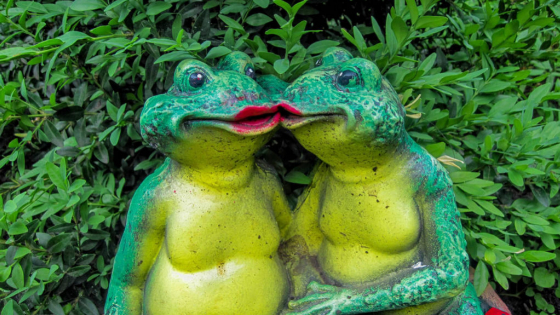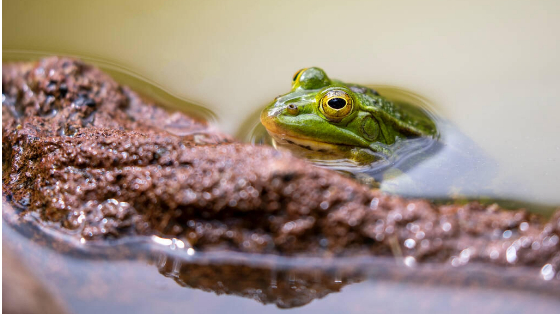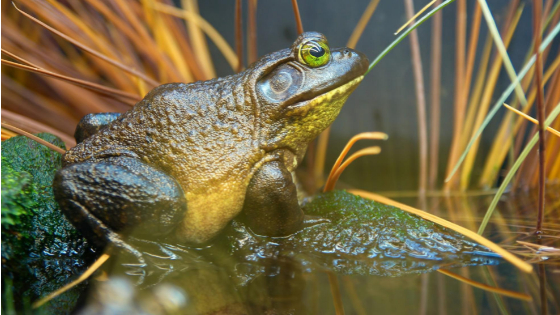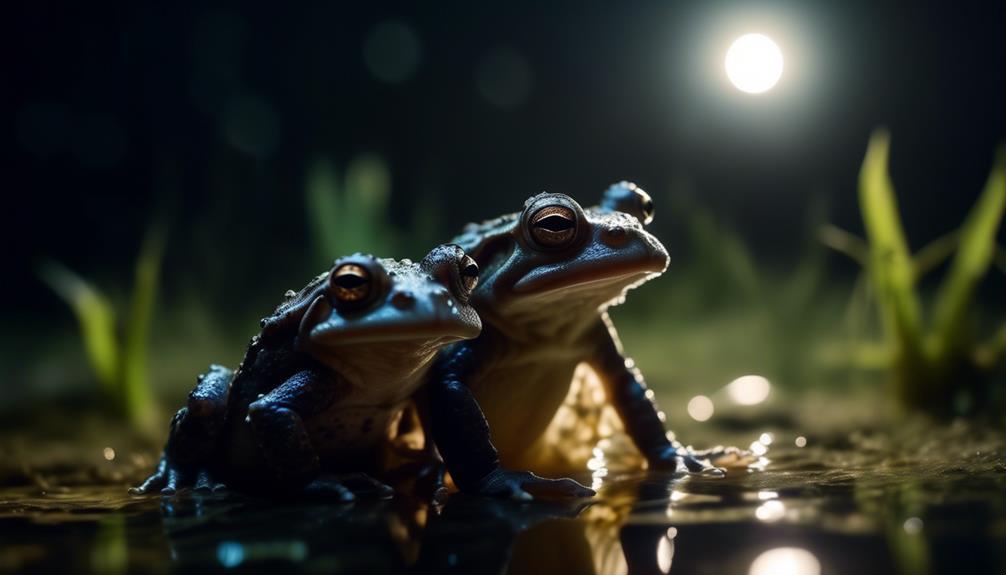
The enigmatic midwife toad, with its captivating parenting behavior, offers a remarkable glimpse into the intricacies of nature. This small amphibian species, found in northwestern Europe, possesses unique physical characteristics and adapts to diverse environments.
However, it is their reproductive behavior that truly sets them apart. Unlike other amphibians, male midwife toads actively participate in egg fertilization and care, showcasing an unparalleled level of commitment.
As we delve into the fascinating world of these masters of parenting, we will uncover the astonishing adaptations, ecological significance, and conservation challenges they face, leaving us with a renewed appreciation for the wonders of the natural world.
Key Takeaways
- The common midwife toad is a small amphibian found in northwestern Europe, with a size of up to 5.5 centimeters.
- They have a stocky body, prominent eyes, and smooth skin with warts and granules.
- The toads have distinct color variations, ranging from gray to olive or brown, with large reddish or yellow warts.
- They are active at night, hiding during the day, and can be found in various habitats near water, such as hilly areas, cultivated land, and gardens.
Physical Characteristics
The common midwife toad possesses distinct physical characteristics that contribute to its unique appearance and behavior.
This species of toad grows up to 5.5 centimeters in length and has a broad, stocky body with a large head and prominent eyes. Its skin is mostly smooth, with a few small warts and granules. The toad also has parotoid glands, as well as additional glands in the underarm and ankle regions.
The color of the toad varies, often being gray, olive, or brown, with large warts that can be reddish or yellow. These physical features help the midwife toad blend into its environment and protect itself from predators.
Additionally, the distinct appearance of the midwife toad plays a role in its reproductive behavior, as males and females recognize and select each other based on these physical characteristics.
Distribution and Habitat
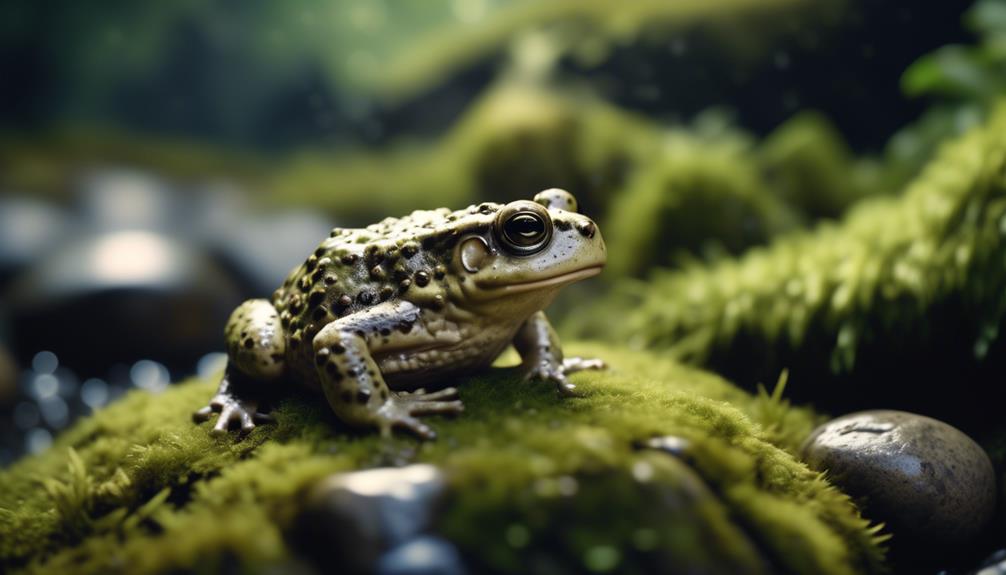
Covering northwestern Europe, including France, Belgium, the Netherlands, Germany, and Switzerland, the common midwife toad is known for its wide-ranging distribution and adaptable habitat. This fascinating amphibian can also be found in disconnected populations in Portugal and northern Spain. Despite being primarily associated with water, the common midwife toad can venture up to 500 meters away from its aquatic habitats. It thrives in various environments, including hilly areas, cultivated land, quarries, woods, and even gardens. Active during dusk and night, the toad seeks refuge during the day in undergrowth or crevices. Its ability to inhabit diverse habitats allows for its survival and contributes to its enigmatic nature.
- The common midwife toad is found in northwestern Europe, Portugal, and northern Spain.
- It can adapt to various environments like hilly areas, cultivated land, quarries, woods, and gardens.
- Despite being associated with water, it can wander up to 500 meters away from aquatic habitats.
Systematics and Subspecies
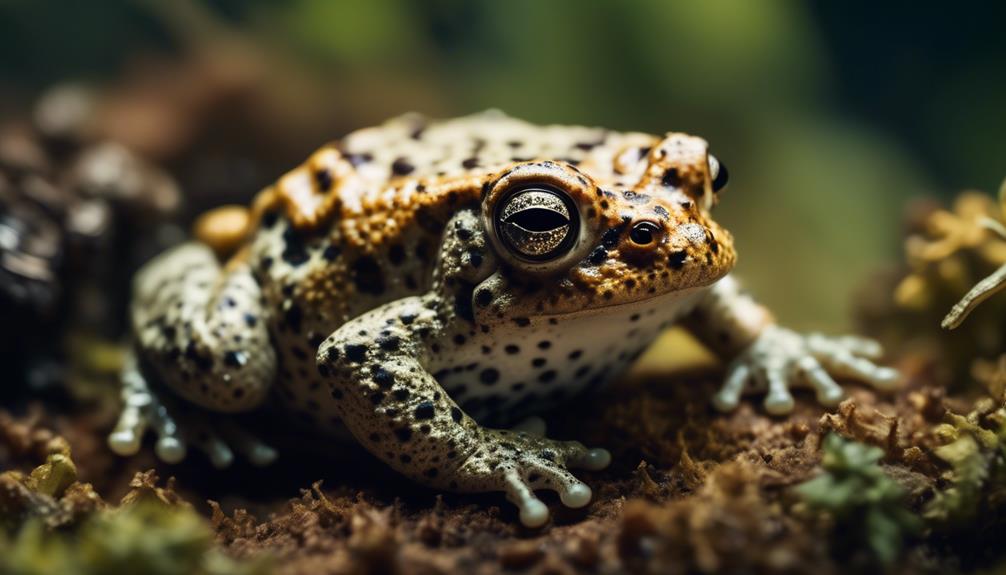
With a focus on the classification and variations within the common midwife toad species, the subtopic of ‘Systematics and Subspecies’ sheds light on the distinct genetic makeup and evolutionary history of this enigmatic amphibian.
The common midwife toad, scientific name Alytes obstetricans, comprises four recognized subspecies: A. o. almogavarii, A. o. boscai, A. o. obstetricans, and A. o. pertinax. Among these, A. o. obstetricans has the widest distribution, while the other three subspecies are localized to the Iberian Peninsula.
These subspecies are believed to have emerged during the Plio-Pleistocene period, in glacial refugia conditions. Notably, A. o. almogavarii has been proposed as an independent incipient species due to its genetic divergence.
Understanding the systematics and subspecies of the common midwife toad is crucial for conservation efforts, as each subspecies possesses unique genetic traits.
Behavior and Reproduction
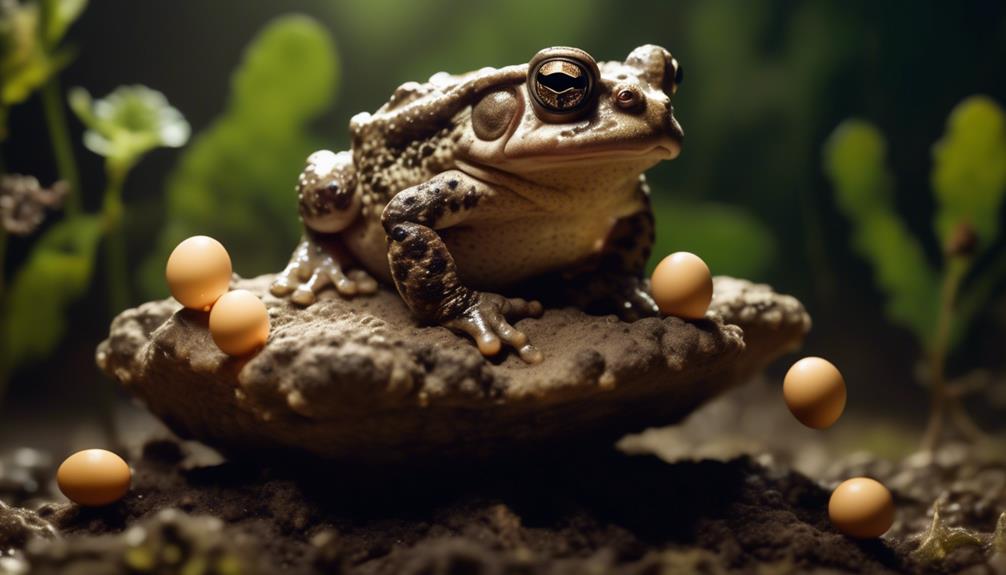
During the breeding season, the common midwife toad exhibits fascinating behaviors and unique reproductive strategies.
- When threatened, the midwife toad inflates itself and assumes a threatening posture.
- Reproduction occurs in spring and summer, with females selecting larger males.
- Males stimulate the female’s cloaca with their toes and then squeeze her sides to induce egg laying.
These behaviors are crucial for the survival of the species.
The male midwife toad takes an active role in parenting by carrying the egg mass around his back legs. This behavior, known as ‘back-riding,’ allows the male to keep the eggs moist and protected from predators. In addition, the male may secrete a protective substance through his skin to further enhance the survival chances of the developing embryos.
The unique reproductive strategies of the common midwife toad highlight their exceptional parental care and emphasize the importance of understanding and conserving these enigmatic creatures.
Threatening Posture
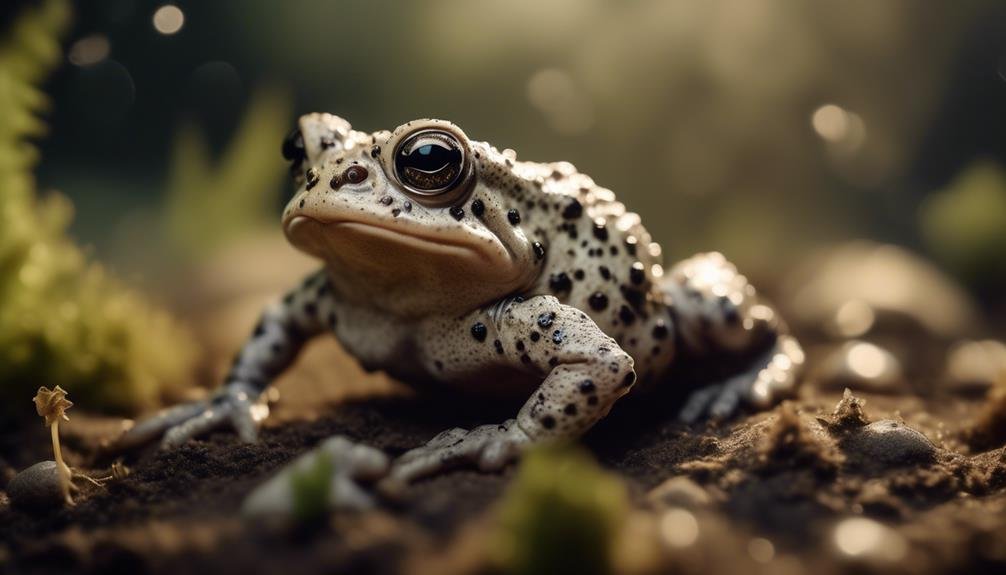
The common midwife toad, known for its fascinating behaviors and unique reproductive strategies, displays a distinct threatening posture when faced with threats.
When the midwife toad feels threatened, it inflates itself and assumes a posture that aims to intimidate its predator or attacker. This posture involves arching its back, raising its head, and opening its mouth wide to display its sharp teeth. Additionally, the toad may emit a loud, high-pitched call to further deter its aggressor.
This threatening posture serves as a warning signal, indicating that the toad is prepared to defend itself if necessary. The midwife toad’s ability to adopt such a posture showcases its adaptability and resourcefulness in dealing with potential dangers in its environment.
Mating Behavior

The common midwife toad’s intriguing repertoire of behaviors extends beyond its threatening posture, as its unique mating behavior unfolds with remarkable intricacy. During the mating season, males and females engage in a fascinating ritual that showcases the toad’s remarkable parenting skills.
Here are three key aspects of the midwife toad’s mating behavior:
- Female Selection: Females are known to be selective when choosing a mate, often preferring larger males. This preference might be influenced by the male’s ability to provide better care for the offspring.
- Stimulating Egg Laying: Males stimulate the female’s cloaca with their toes and then gently squeeze her sides to induce egg laying. This process ensures the successful fertilization of the eggs.
- Parental Care: Once the eggs are laid, the male wraps the egg mass around his back legs. He carries the eggs with him, keeping them moist and potentially secreting a protective substance through his skin. This unique form of parental care is rarely seen in other amphibian species.
The midwife toad’s mating behavior showcases the complexity and dedication these amphibians have towards reproduction and parenting.
Male Parental Care
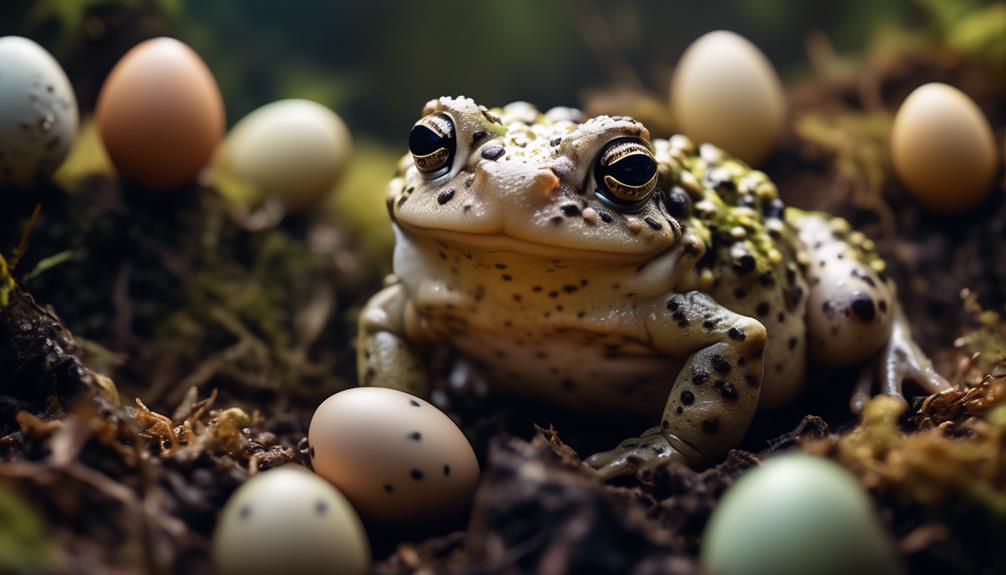
Male midwife toads exhibit remarkable dedication and care towards their offspring, engaging in a unique form of parental care rarely observed in other amphibian species. After mating, the female midwife toad lays her eggs and the male takes over the responsibility of caring for them. He wraps the egg mass around his back legs and carries it until the tadpoles are ready to hatch. During this time, the male ensures that the eggs remain moist and safe from predators. He may even secrete a protective substance through his skin to further safeguard the eggs. This level of paternal care is exceptional among amphibians and showcases the commitment of male midwife toads towards their offspring’s survival.
| Male Parental Care | |
|---|---|
| Responsibility | Caring for the eggs |
| Role | Carrying the egg mass |
| Protection | Keeping the eggs moist and safe |
| Secretion | Possibly secreting a protective substance through the skin |
| Commitment | Exceptional dedication towards offspring’s survival |
Female Selection of Mates
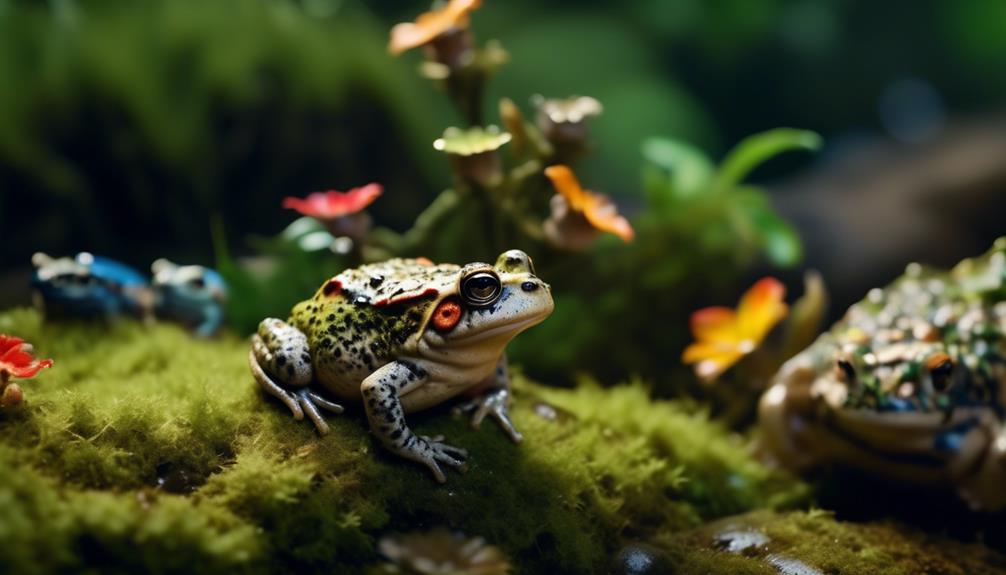
Female midwife toads play a crucial role in the reproductive process by selectively choosing their mates. This behavior ensures the quality and genetic diversity of their offspring.
The process of female selection of mates in midwife toads involves the following:
- Vocalizations: Males produce complex calls to attract females, showcasing their fitness and genetic quality.
- Size preference: Females tend to choose larger males, who are often more experienced and possess higher energy reserves for parental care.
- Visual cues: Females may rely on visual cues, such as bright coloration or unique markings, to assess the health and genetic fitness of potential mates.
Diet and Feeding Habits
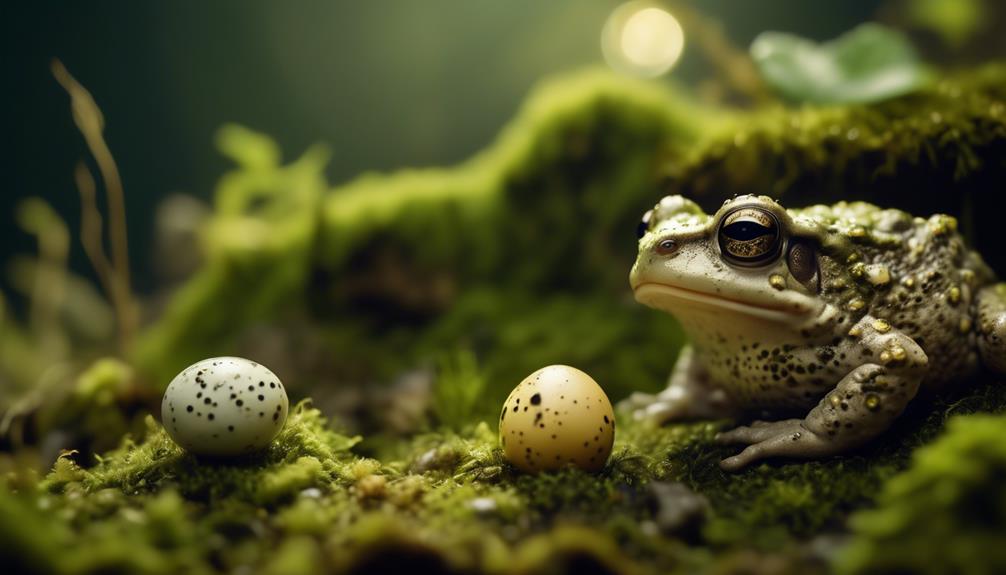
In addition to their selective mating behaviors, midwife toads exhibit specific dietary preferences and feeding habits. Common midwife toads primarily feed on insects and other arthropods, making them insectivores. They have a specialized diet that consists mainly of small invertebrates, such as beetles, spiders, and worms. Additionally, midwife toads have been observed consuming carrion, further expanding their feeding habits. To provide a clearer understanding of their diet, the following table outlines the common midwife toad’s preferred food sources:
| Dietary Preferences | Feeding Habits |
|---|---|
| Insects | Insectivorous |
| Arthropods | |
| Carrion | Opportunistic |
These dietary preferences and feeding habits play a crucial role in the midwife toad’s overall ecological niche and contribute to their survival and reproductive success.
Importance of Genetic Conservation
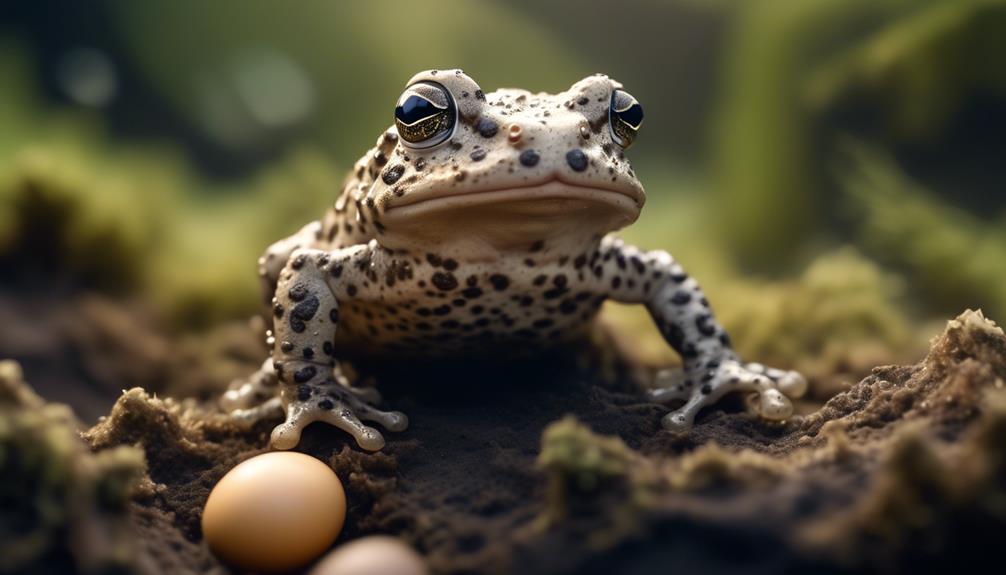
The preservation of the distinct genetic makeup of each subspecies of the common midwife toad is of utmost importance for their long-term conservation. Genetic conservation plays a crucial role in maintaining the biodiversity and ecological balance of our planet.
Here are three reasons why genetic conservation is important for the common midwife toad:
- Preservation of unique adaptations: Each subspecies of the common midwife toad has developed unique adaptations to their specific habitats and environmental conditions. By conserving their genetic makeup, we ensure the preservation of these valuable adaptations, allowing the toads to thrive in their respective ecosystems.
- Prevention of inbreeding and loss of genetic diversity: Genetic conservation helps prevent inbreeding and the loss of genetic diversity within populations. By maintaining healthy genetic variation, we enhance the toads’ ability to adapt to changing environments and reduce the risk of genetic diseases.
- Future research and potential discoveries: The genetic diversity of the common midwife toad holds valuable information that can contribute to scientific research and potential discoveries. By conserving their genetic makeup, we provide opportunities for future studies on their evolutionary history, behavior, and potential medical applications.
Genetic conservation efforts are essential for the long-term survival and well-being of the common midwife toad and other species. Through these efforts, we can protect their genetic heritage and ensure a sustainable future for our planet.
Nighttime Activity Patterns
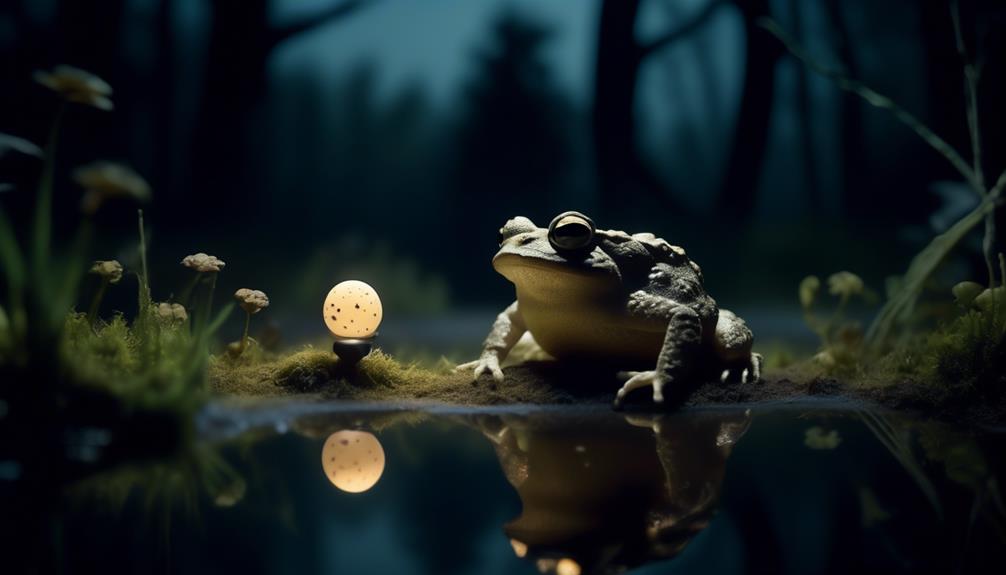
To understand the comprehensive behavior of the common midwife toad, it is essential to explore its nighttime activity patterns. These toads are primarily nocturnal, meaning they are most active during the night.
During this time, they emerge from their hiding places in undergrowth or crevices to search for food and engage in other behaviors. The nighttime activity patterns of the common midwife toad include foraging for insects and other arthropods, as well as engaging in courtship and mating rituals.
This is also the time when they may encounter predators and utilize their defensive behaviors, such as inflating themselves and assuming threatening postures. By studying their nighttime activity patterns, we can gain a better understanding of their ecological role and the factors that influence their behavior.
Adaptation to Various Environments
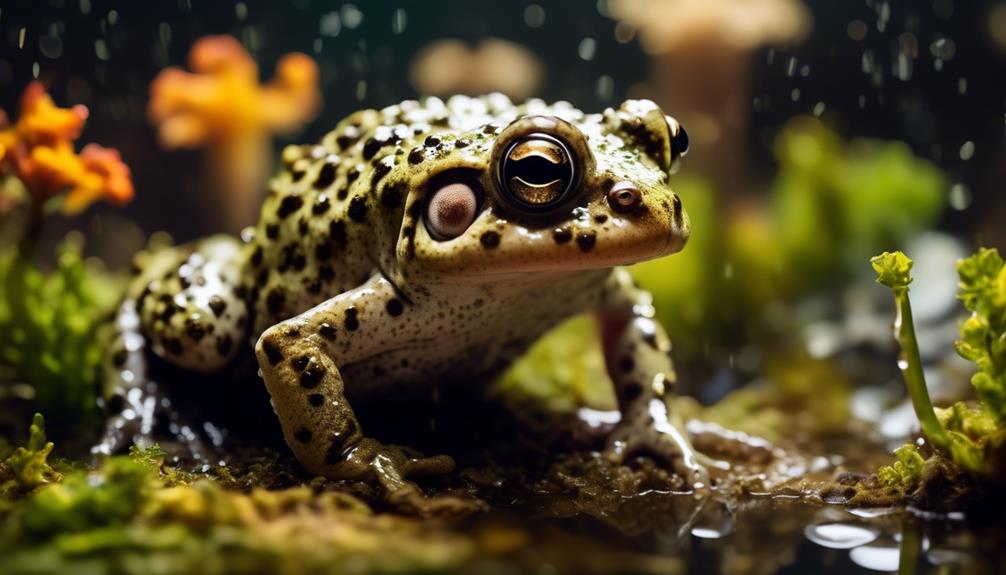
Demonstrating remarkable adaptability, the common midwife toad has evolved to thrive in a diverse range of environments. This unique species has developed specific adaptations that allow it to navigate and survive in various habitats.
- Amphibious Lifestyle: The common midwife toad is well-suited for both aquatic and terrestrial life. It can be found near water bodies like ponds, streams, and even garden fountains, where it breeds and lays its eggs. However, it is also capable of venturing away from water, exploring hilly areas, cultivated land, quarries, and even gardens.
- Nocturnal Behavior: The midwife toad is primarily active during the night, taking advantage of the cover and reduced competition for resources. This adaptation enables it to avoid predators and find suitable prey items more efficiently.
- Camouflaging Abilities: The toad’s variable coloration, often gray, olive, or brown, helps it blend into its surroundings, making it harder for predators to spot. Additionally, its smooth skin, speckled with small warts and granules, provides further camouflage and protection.
These remarkable adaptations allow the common midwife toad to thrive in a wide range of environments, ensuring its survival and success as a species.
Frequently Asked Questions
How Long Can the Common Midwife Toad Grow?
The common midwife toad can grow up to 5.5 centimeters in length. Its broad and stocky body, large head, and prominent eyes contribute to its physical characteristics.
What Are the Different Subspecies of the Common Midwife Toad?
The different subspecies of the common midwife toad are A. o. almogavarii, A. o. boscai, A. o. obstetricans, and A. o. pertinax. These subspecies formed during glacial refugia conditions in the Plio-Pleistocene period and each possess distinct genetic characteristics.
How Do the Male Midwife Toads Care for the Eggs?
Male midwife toads care for the eggs by wrapping the egg mass around their back legs. They keep the eggs moist and may secrete a protective substance through their skin. This unique parenting behavior is a remarkable adaptation among amphibians.
What Is the Diet of the Common Midwife Toad?
The diet of the common midwife toad primarily consists of insects and other arthropods. They also consume carrion as part of their diet. This feeding behavior allows them to meet their nutritional needs and sustain their reproductive efforts.
Why Is Genetic Conservation Important for the Different Subspecies of the Common Midwife Toad?
Genetic conservation is important for the different subspecies of the common midwife toad because each subspecies has distinct genetic makeup. Conserving their unique genetics ensures their survival and helps maintain biodiversity within the species.
Are Midwife Toads and Western Toads Related in Their Parenting Behavior?
Midwife toads and the elusive western toad rocky mountain may appear unrelated, but they share similar parenting behavior. Both species exhibit male parental care, with the male carrying the eggs on their hind legs until they hatch. This unique parenting strategy sets them apart from other amphibians.
Conclusion
In conclusion, the enigmatic midwife toad is a fascinating amphibian species with distinct physical characteristics and unique parenting behavior. Endemic to northwestern Europe, these toads inhabit diverse environments and play a vital role within their ecosystems.
Their active role in egg fertilization and care sets them apart from other amphibians. The midwife toad’s adaptive behavior, genetic conservation, and nighttime activity patterns further contribute to their ecological significance.
Overall, these masters of parenting provide a captivating subject for further research and conservation efforts.

